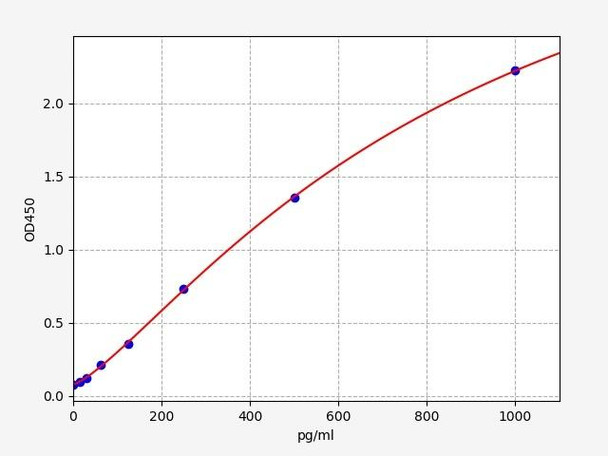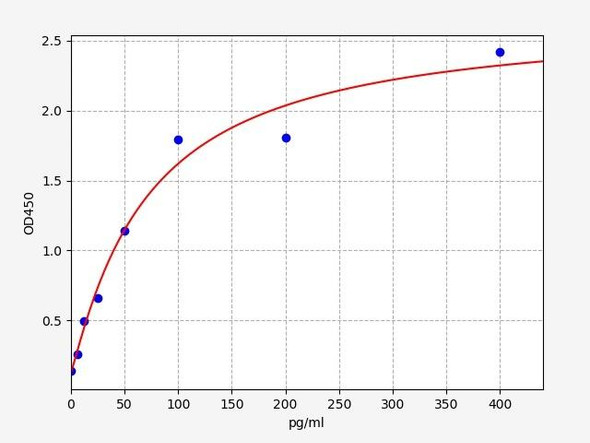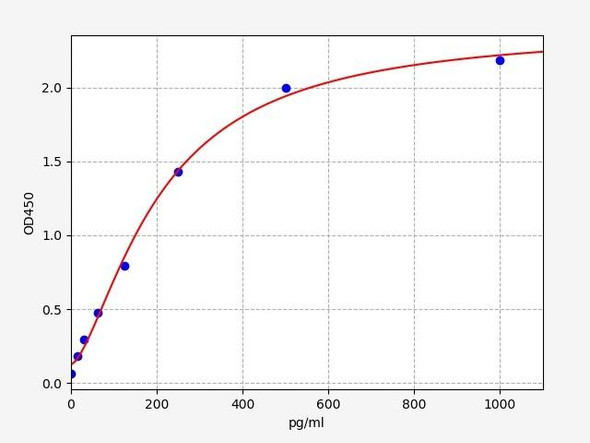Canine IL-8 ELISA Kit
- SKU:
- CNFI00014
- Product Type:
- ELISA Kit
- Size:
- 96 Assays
- Uniprot:
- P41324
- Sensitivity:
- 9.375pg/ml
- Range:
- 15.625-1000pg/ml
- ELISA Type:
- Sandwich
- Synonyms:
- IL-8, IL8, CXCL8, GCP-1, GCP1, LECT, LUCT, LYNAP, MDNCF, MONAP, NAF, NAP-1, NAP1, 3-10C, AMCF-I, K60
- Reactivity:
- Canine
- Signaling Molecule:
- Cytokine
Description
Canine IL-8 ELISA Kit
Key Features
| Save Time | Pre-coated 96 well plate | |
| Quick Start | Kit includes all necessary reagents | |
| Publication Ready | Reproducible and reliable results |
Overview
|
Product Name: |
Canine IL-8 (Interleukin 8) ELISA Kit |
|
Product Code: |
CNFI00014 |
|
Size: |
96 Assays |
|
Target: |
Canine IL-8 |
|
Alias: |
IL-8, IL8, CXCL8, GCP-1, GCP1, LECT, LUCT, LYNAP, MDNCF, MONAP, NAF, NAP-1, NAP1, 3-10C, AMCF-I, K60 |
|
Reactivity: |
Canine |
|
Detection Method: |
Sandwich ELISA, Double Antibody |
|
Sensitivity: |
9.375pg/ml |
|
Range: |
15.625-1000pg/ml |
|
Storage: |
4°C for 6 months |
|
Note: |
For Research Use Only |
Additional Information
|
Recovery |
Matrices listed below were spiked with certain level of Canine IL-8 and the recovery rates were calculated by comparing the measured value to the expected amount of Canine IL-8 in samples.
|
||||||||||||||||||||
|
Linearity: |
The linearity of the kit was assayed by testing samples spiked with appropriate concentration of Canine IL-8 and their serial dilutions. The results were demonstrated by the percentage of calculated concentration to the expected.
|
||||||||||||||||||||
|
Intra-Assay: |
CV <8% |
||||||||||||||||||||
|
Inter-Assay: |
CV <10% |
Protein Information
|
Uniprot: |
|
|
UniProt Protein Function: |
Function: IL-8 is a chemotactic factor that attracts neutrophils, basophils, and T-cells, but not monocytes. It is also involved in neutrophil activation. It is released from several cell types in response to an inflammatory stimulus. |
|
UniProt Code: |
|
|
NCBI GenInfo Identifier: |
|
|
NCBI Gene ID: |
|
|
NCBI Accession: |
|
|
UniProt Related Accession: |
|
|
Molecular Weight: |
11,280 Da |
|
NCBI Full Name: |
interleukin-8 |
|
NCBI Official Symbol: |
CXCL8 |
|
NCBI Official Synonym Symbols: |
IL8 |
|
NCBI Protein Information: |
interleukin-8; IL-8; C-X-C motif chemokine 8; chemokine (C-X-C motif) ligand 8 |
|
UniProt Protein Name: |
Interleukin-8 |
|
UniProt Synonym Protein Names: |
C-X-C motif chemokine 8; Chemokine (C-X-C motif) ligand 8 |
|
UniProt Gene Name: |
CXCL8 |
|
UniProt Entry Name: |
IL8_CANFA |
Protocol
*Note: Protocols are specific to each batch/lot. For the exact instructions please follow the protocol included in your kit.
| Step | Procedure |
|
1. |
Set standard, test sample and control (zero) wells on the pre-coated plate respectively, and then, record their positions. It is recommended to measure each standard and sample in duplicate. Wash plate 2 times before adding standard, sample and control (zero) wells! |
|
2. |
Aliquot 0.1ml standard solutions into the standard wells. |
|
3. |
Add 0.1 ml of Sample / Standard dilution buffer into the control (zero) well. |
|
4. |
Add 0.1 ml of properly diluted sample ( Human serum, plasma, tissue homogenates and other biological fluids.) into test sample wells. |
|
5. |
Seal the plate with a cover and incubate at 37 °C for 90 min. |
|
6. |
Remove the cover and discard the plate content, clap the plate on the absorbent filter papers or other absorbent material. Do NOT let the wells completely dry at any time. Wash plate X2. |
|
7. |
Add 0.1 ml of Biotin- detection antibody working solution into the above wells (standard, test sample & zero wells). Add the solution at the bottom of each well without touching the side wall. |
|
8. |
Seal the plate with a cover and incubate at 37°C for 60 min. |
|
9. |
Remove the cover, and wash plate 3 times with Wash buffer. Let wash buffer rest in wells for 1 min between each wash. |
|
10. |
Add 0.1 ml of SABC working solution into each well, cover the plate and incubate at 37°C for 30 min. |
|
11. |
Remove the cover and wash plate 5 times with Wash buffer, and each time let the wash buffer stay in the wells for 1-2 min. |
|
12. |
Add 90 µl of TMB substrate into each well, cover the plate and incubate at 37°C in dark within 10-20 min. (Note: This incubation time is for reference use only, the optimal time should be determined by end user.) And the shades of blue can be seen in the first 3-4 wells (with most concentrated standard solutions), the other wells show no obvious color. |
|
13. |
Add 50 µl of Stop solution into each well and mix thoroughly. The color changes into yellow immediately. |
|
14. |
Read the O.D. absorbance at 450 nm in a microplate reader immediately after adding the stop solution. |
Sample Preparation
When carrying out an ELISA assay it is important to prepare your samples in order to achieve the best possible results. Below we have a list of procedures for the preparation of samples for different sample types.
| Sample Type | Protocol |
|
Serum |
If using serum separator tubes, allow samples to clot for 30 minutes at room temperature. Centrifuge for 10 minutes at 1,000x g. Collect the serum fraction and assay promptly or aliquot and store the samples at -80°C. Avoid multiple freeze-thaw cycles. If serum separator tubes are not being used, allow samples to clot overnight at 2-8°C. Centrifuge for 10 minutes at 1,000x g. Remove serum and assay promptly or aliquot and store the samples at -80°C. Avoid multiple freeze-thaw cycles. |
|
Plasma |
Collect plasma using EDTA or heparin as an anticoagulant. Centrifuge samples at 4°C for 15 mins at 1000 × g within 30 mins of collection. Collect the plasma fraction and assay promptly or aliquot and store the samples at -80°C. Avoid multiple freeze-thaw cycles. Note: Over haemolysed samples are not suitable for use with this kit. |
|
Urine & Cerebrospinal Fluid |
Collect the urine (mid-stream) in a sterile container, centrifuge for 20 mins at 2000-3000 rpm. Remove supernatant and assay immediately. If any precipitation is detected, repeat the centrifugation step. A similar protocol can be used for cerebrospinal fluid. |
|
Cell culture supernatant |
Collect the cell culture media by pipette, followed by centrifugation at 4°C for 20 mins at 1500 rpm. Collect the clear supernatant and assay immediately. |
|
Cell lysates |
Solubilize cells in lysis buffer and allow to sit on ice for 30 minutes. Centrifuge tubes at 14,000 x g for 5 minutes to remove insoluble material. Aliquot the supernatant into a new tube and discard the remaining whole cell extract. Quantify total protein concentration using a total protein assay. Assay immediately or aliquot and store at ≤ -20 °C. |
|
Tissue homogenates |
The preparation of tissue homogenates will vary depending upon tissue type. Rinse tissue with 1X PBS to remove excess blood & homogenize in 20ml of 1X PBS (including protease inhibitors) and store overnight at ≤ -20°C. Two freeze-thaw cycles are required to break the cell membranes. To further disrupt the cell membranes you can sonicate the samples. Centrifuge homogenates for 5 mins at 5000xg. Remove the supernatant and assay immediately or aliquot and store at -20°C or -80°C. |
|
Tissue lysates |
Rinse tissue with PBS, cut into 1-2 mm pieces, and homogenize with a tissue homogenizer in PBS. Add an equal volume of RIPA buffer containing protease inhibitors and lyse tissues at room temperature for 30 minutes with gentle agitation. Centrifuge to remove debris. Quantify total protein concentration using a total protein assay. Assay immediately or aliquot and store at ≤ -20 °C |
|
Breast Milk |
Collect milk samples and centrifuge at 10,000 x g for 60 min at 4°C. Aliquot the supernatant and assay. For long term use, store samples at -80°C. Minimize freeze/thaw cycles. |
Canine IL-8 Background
Interleukin-8 is a cytokine that plays a crucial role in the immune system's response to inflammation and infection. It is produced by various cell types, including immune cells, epithelial cells, and fibroblasts. IL-8 acts as a chemokine, functioning as a signaling molecule to attract and activate immune cells.
Functions of IL-8
IL-8 serves several important functions in the immune response. One of its primary roles is to recruit and guide neutrophils, a type of white blood cell, to the site of infection or inflammation. IL-8 binds to specific receptors on neutrophils, facilitating their migration from the bloodstream to the affected tissues. Additionally, IL-8 can activate neutrophils, enhancing their ability to eliminate pathogens and produce antimicrobial substances.
IL-8 in Inflammation
IL-8 plays a significant role in amplifying the inflammatory response. It can promote the release of other pro-inflammatory cytokines and chemokines, further enhancing the immune response. IL-8 also facilitates the adhesion of immune cells to the blood vessel walls, aiding their recruitment to the site of infection or inflammation.
Implications in Disease
Elevated levels of IL-8 are often associated with various diseases and conditions characterized by inflammation. Infections, autoimmune disorders, chronic inflammatory diseases, and certain types of cancer are examples of conditions in which IL-8 may be involved. Monitoring IL-8 levels can provide insights into ongoing inflammation and immune activation.
Canine IL-8 FAQs
What is the Canine IL-8 ELISA Kit used for?
The Canine IL-8 ELISA Kit is specifically designed for the detection and measurement of interleukin-8 (IL-8) in biological samples. It allows researchers and veterinarians to quantify the concentration of IL-8, an important cytokine involved in the immune response and inflammation in canines.
What are the benefits of using the Canine IL-8 ELISA Kit?
The Canine IL-8 ELISA Kit offers specific and accurate measurements of IL-8 in canine samples, enabling researchers and veterinarians to quantify IL-8 levels with high sensitivity. It is user-friendly, compatible with various sample types, and serves both research and diagnostic purposes, providing valuable insights into canine inflammation and immune responses.
Where can I find more information about the Canine IL-8 ELISA Kit?
For more detailed information about the Canine IL-8 ELISA Kit, including technical specifications, performance characteristics, and ordering details, please refer to the product brochure or contact our customer support team. We are here to assist you with any inquiries you may have.






